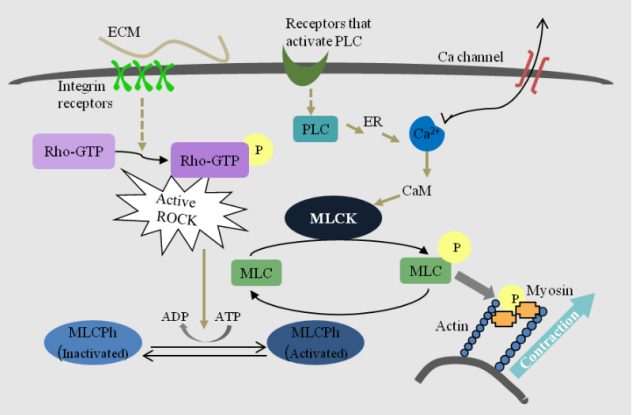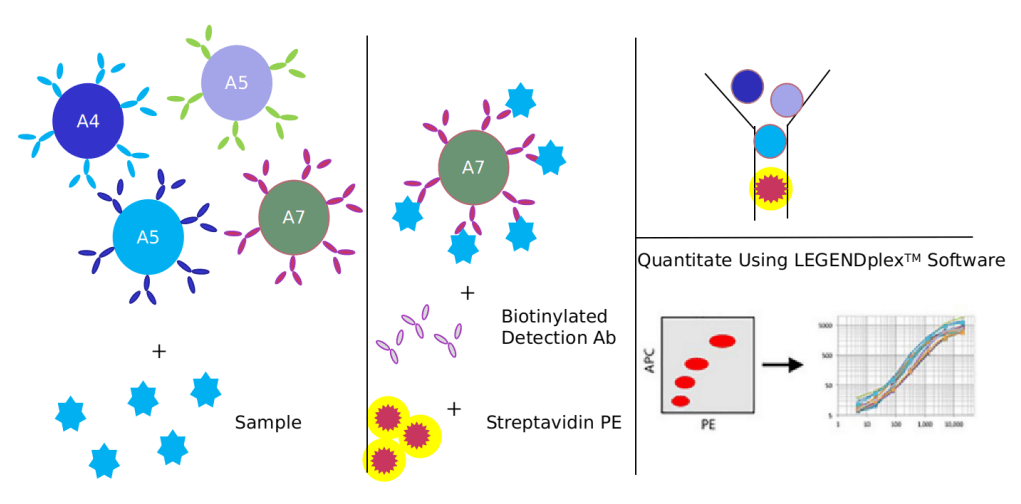ROCK signaling pathway
Based on Luminex technology platform, Creative Proteomics provides analysis services for key targets of ROCK signaling pathway.
Rho-associated kinase (ROCK) is currently the most detailed functional study of Rho downstream target effect molecules. The ROCK signaling pathway induces cytoskeletal reorganization, cell migration and stress fiber formation, and has various physiological functions such as endothelial permeability, tissue contraction and growth. Related, involved in the occurrence of diseases such as diabetic nephropathy, eye diseases, tumors, heart disease, neurological damage diseases, hypertension, radiation damage and leukemia, as a target of drug research and development, people are getting more and more attention.
 (Wang Y, Zheng XR, et al., 2019)The ROCK signal path includes:
(Wang Y, Zheng XR, et al., 2019)The ROCK signal path includes:
- Inhibitory proteins (inhibition signals): such as myelin associated glycoprotein (MAG), neuronal growth inhibitor (including Nogo-A, Nogo-B and Nogo-C) and oligodendrocytes Myelin glycoprotein (oligodendrocyte myelin glycoprotein, OMgp).
- Receptors that can bind to the inhibitory protein: such as Nogo receptor (NgR), paired immunoglobulin-like receptor B (PirB), p75 neurotrophic receptor (p75 neurotrophic receptor, p75NTR).
- Rho factor.
- ROCK and ROCK effector molecules.
Various extracellular inhibitory signals (such as Nogo-A) combine with p75NTR to form an NgR-p75NTR complex and are transmitted in the cytoplasm, which then activates Rho factor, turning it from inactive Rho-GDP to active Rho-GTP The latter in turn activates ROCK, which leads to the collapse of growth cones by affecting the actin-globulin system, inhibiting nerve cell proliferation and cell regeneration.
ROCK signaling pathway may be involved in the remodeling of actin cytoskeleton and cell morphology changes in breast cancer cells caused by hypoxia.
Our detectable targets:
| MSK2 | SLP76 | p38MAPK | MYD88 | Rac1 | TLR4 |
| ATG16 | WIPi2 | LC3I | PROLC3 | ULK | FIP200 |
| TRIF | VPS34 | UYRAG | NFκB | RIG-1 | p50 |
| Vav | IRF9 | AMBRA1 | p38 | RIP1 | TRAF5 |
| Histone-H3 | IRF5 | MEK3 | mTOR | SH2 | TRAF6 |
| ATG3 | IRS1 | MEK6 | PKR | ISRE | TRAM |
| ISGF3 | IRS2 | MSK1 | p65 | Tak1 | TBK1 |
Technology platform:
We provide Luminex technology for ROCK signaling pathway analysis.
Luminex technology is a multifunctional liquid phase analysis platform, developed on the basis of color microspheres, laser technology, applied fluid science and high-speed digital signal processing technology. It core is to encode polypropylene microspheres or magnetic microspheres with fluorescent dyes. By adjusting the different ratios of the two fluorescent dyes, up to 100 microspheres with different fluorescence spectra can be obtained. Antigen-antibody, enzyme-substrate, ligand-receptor binding reactions and nucleic acid hybridization reactions were performed on microspheres with different fluorescence codes. The microsphere coding and reporting fluorescence were analyzed qualitatively and quantitatively by laser detection.
The ROCK signal pathway is a ubiquitous pathway in the central nervous system, and it is an important way to mediate inhibitory signals and block the regeneration of central nerve cells.
In addition to Luminex Multiplex Assay, Flow cytometry (FACS analysis), Enzyme-linked immunosorbent assay (ELISA) technology can also be provided to meet other customer needs.
Advantages of ROCK signaling pathway detection:
- High accuracy: When unwashed, the fluorescence intensity of the reporter molecule on the microsphere is proportional to the binding molecule to be detected. The error is further reduced by the large detection range of the Luminex assay platform, which does not require dilution like ELISA assays.
- High sensitivity: The surface area of the microspheres is large, and 100,000 probes can be fixed on each microsphere, which ensures the maximum binding with the target molecules in the sample and improves the detection sensitivity. The lowest detection concentration can reach 0.1pg/mL.
- Strong specificity: Reads fluorescent signals on individual microspheres and automatically distinguishes between bound and unbound microspheres.

Application of our service:
- Study the impact of each clinical virus on the ROCK signaling pathway
- Research on the regulatory mechanism of ROCK signaling pathway in medicine
- Study the effects of drugs or therapies on the ROCK signaling pathway
Creative Proteomics has developed a signaling pathway target detection platform. We can provide detection services not only for apoptotic signaling pathways, but also for other signaling pathways. If you want to detect other targets, please contact us in advance and we will customize the service for you according to your requirements. Looking forward to working with you.
References:
- Wang Y, Zheng XR, et al. ROCK isoform regulation of myosin phosphatase and contractility in vascularsmooth muscle cells. Cire Res, 2019, 104(4): 531-540.
- Zohrabian VM, Forzani B, et al. ROCK and MAPK signaling pathways are involved in glioblastoma cell migration and proliferation. Anticancer Res, 2019, 29(1): 119-123.



